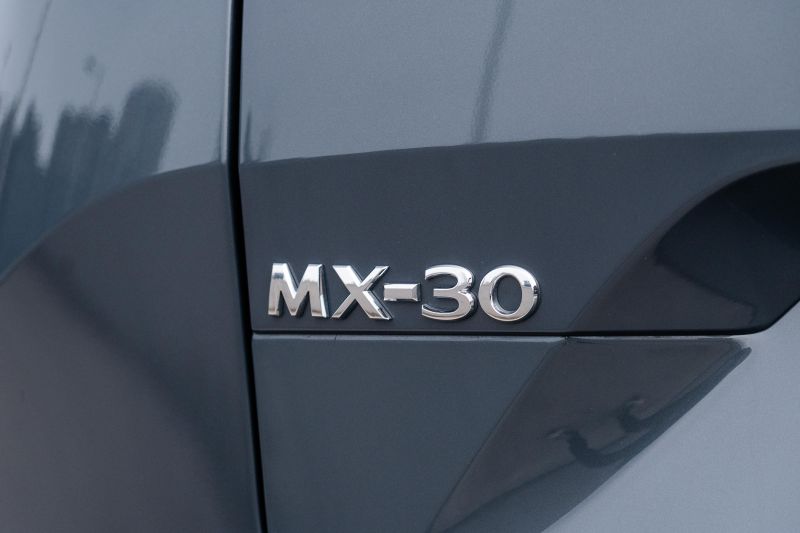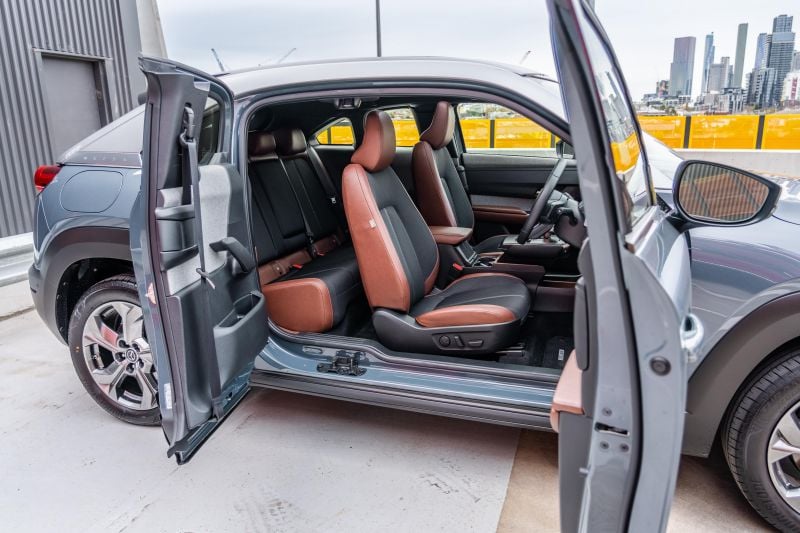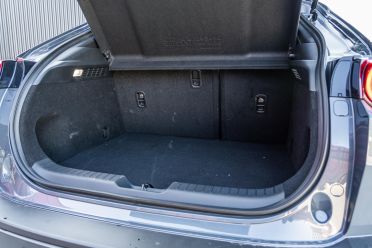The Mazda MX-30 is one of the more interesting offerings in the brand’s line-up, particularly the all-electric version we have on test.
Bearing the Mazda Experiment (MX) badge, which has adorned the iconic MX-5 roadster as well as the MX-3 and MX-6 sports cars of the ’80s and ’90s, this crossover ‘coupe’ of sorts is a mish-mash of Mazda bits.
It has the ‘freestyle doors’ of the RX-8, the platform from the Mazda 3 and CX-30 compact models, and sustainable cork interior bits that are a nod to the company’s history as a cork manufacturer in the 1920s.
What’s new is its electric powertrain, which marks Mazda’s first foray into the EV world. It was revealed in 2018, but only made the trip to Australia in 2021 which, by that point, meant it had quite a few competitors with more power, more range, and more affordable prices.
So while Mazda will peddle its holistic approach to sustainability and “right-sized” battery pack for urban commuting and ‘zoom-zoom’ feel behind the wheel to justify some of the MX-30’s spec shortcomings against competitors, can it make a case for itself against the likes of the Tesla Model 3 and Hyundai Kona Electric in Australia?
Let’s answer that $65,000 question, shall we?

How much does the Mazda MX-30 E35 Astina cost?
Unlike the mild-hybrid petrol version, the MX-30 Electric is only available in flagship Astina trim, with a list price of $65,490 plus on-road costs – or $24,300 more than the equivalent G20e Astina.
You’ll be paying just over $71,000 drive-away according to Mazda’s website, based on a Melbourne postcode.
The MX-30 E35 Astina is priced against a number of EVs, though just about all of them claim to have more driving range – a key metric in Australia’s range-anxious market.
2022 Mazda MX-30 pricing:
- Mazda MX-30 G20e Evolve: $34,190
- Mazda MX-30 G20e Touring: $36,690
- Mazda MX-30 G20e Astina: $41,190
- Mazda MX-30 E35 Astina: $65,490
Key rivals include:
- Hyundai Kona Electric Highlander Standard Range: $58,000
- Kia Niro EV S: $65,300
- Mini Cooper SE Hatch Mini Yours: $62,825
- Nissan Leaf e+: $60,490
All prices exclude on-road costs
What is the Mazda MX-30 E35 Astina like on the inside?
If you’ve sat in a high-spec MX-30 M Hybrid, it’s more of the same here.
There’s the interesting brown Maztex leatherette and cloth upholstery, real cork inserts along the centre console, floating said centre console and a touchscreen climate control panel.
Adding to the visual drama is access into the cabin – through RX-8-style ‘Freestyle Doors’. We don’t use the other name anymore.
The MX-30’s interior, like the exterior, combines typical Mazda bits from other models in the range with some quirkier design and trim elements befitting of the ‘Mazda Experimental’ (or MX) nameplate.
Beyond the saddle brown leatherette and sustainable cork trimmings, there’s also grey fabric on the doors made from recycled PET bottles, and unique takes on the partially-digital instrument cluster and infotainment displays compared to the related CX-30 and Mazda 3.
Naturally, being the only EV in Mazda’s current range, there’s a specific instrument cluster featuring a power meter and EV content. As is the case with all Mazda products running versions of this cluster, it’s clean and easy to navigate – I’m a big fan of the simplistic, minimalist graphics and design.
There’s also a funky little start-up animation that greets you every time you start the car up, as well as an animated graphic when it’s plugged in and charging. It’s the little things.
Jutting out from the upper dash is a 10.25-inch navigation system running Mazda’s newer Mazda Connect interface, which is more squared off and symmetrical than the curved surround in the CX-30 and Mazda 3.
It’s the system we’re seeing roll out across Mazda’s line-up, so its strengths and weaknesses are the same.
The speed and graphics are decent, and if you want to bypass the native software you can use Apple CarPlay and Android Auto, though it’s wired only. Embedded navigation is fine but offers no connected or online functions, and the Bose premium audio system offers crisp sound quality.
Like the instrument cluster, there’s a few extra menus and displays for EV-related content, but it’s still all pretty conventional. This is all fine, but it doesn’t really feel like you’re getting that much extra thrown in for the circa-$20,000 premium over the petrol-powered MX-30.
Ahead of the chunky e-shifter is a touchscreen panel for your climate controls, which unlike some European makes still has proper buttons flanking either side for temperature and fan adjustment, as well as de-mister functions.
It looks slick but is fairly limited in functionality, and annoyingly the ‘eco’ setting for the climate control is a touch-only button. Same goes for the heated front seats and steering wheel, they’re only accessed via the touch display.
Behind the display is a cork-lined shelf that’s large enough to store items like phones, wallets and keys, even small purses or bags.
Added practicality and convenience comes form the dual USB-A outlets in this cubby, as well as a 220V/150W three-point socket for charging or powering items like laptops. Neat!
Comfort up front is good thanks to electric driver’s seat adjustment with memory presets, as well as supportive, comfortable front seats.
The fabric seat inserts are great as they don’t get cold or hot in harsher climates, and I personally prefer the added give of cloth trim. Mazda’s ‘Vintage Brown’ leatherette is a nice switch up from the 50 shades of grey we get in modern car interiors, and is made with no organic solvents which reduces environmental impact.
The driving position is still fairly car-like despite the raised ride height, and there’s quick release levers behind both front seats to quickly get them out of the way if you’re carrying people in the rear. Some coupe-like cues there.
Slightly annoying is the fact you need to take your seatbelt off to open the rear door, a compromise of the pillar-less design. Parents might find that pretty fiddly at the school drop-off, for example.
Being a ‘coupe’ crossover, the rear seats aren’t a top priority. Regardless, there’s a surprising amount of room back there provided occupants aren’t too tall, no doubt a benefit of the MX-30’s shared underpinnings with the CX-30.
At 6’1 I can fit behind my own driving position, though it’s fairly snug. Knee room is probably the biggest complaint, so it’s best left for kids and smaller teenagers or adults. Headroom is on the tighter side due to the sloping roofline, but it’s not as compromised as you might think.
There’s amenities like a fold-down centre armrest with cupholders, and ISOFIX anchors on the outboard seats. Further, there’s top-tethers for all three rear pews – remember this is still technically a five-seater.
Also worth mentioning are the small rear windows. Outward visibility from the second row isn’t great, given the chunky front seats and high set, narrow rear windows. Motion sickness-prone passengers beware.
Mazda quotes a boot volume of 311 litres with the rear seats in place, just 6L down on the related CX-30 despite the coupe styling and EV components under the skin.
The space itself is nice and square, and folding the seats opens that up even more, even if there’s a small hump between the boot floor and rear seatbacks. Mazda also doesn’t quote a boot capacity with the rear seats folded.
I helped a friend move house while I had the MX-30 and was surprised at how much I could actually fit in the boot, though that tapered roofline hindered load height and also meant the small rear window was obscured quickly.
The MX-30 also doesn’t have a spare wheel, instead a puncture repair kit is fitted – it’s a city-focused car, after all.
What’s under the bonnet?
The MX-30 Electric is powered by a front-mounted AC synchronous electric motor generating 107kW and 271Nm, driving through a single-speed transmission.
Feeding the motor is a small 35.5kWh lithium-ion battery pack, which has a maximum DC charging rate of 50kW. At this rate, Mazda claims the MX-30 can recharge from 20 to 80 per cent in 36 minutes.
A 6.6kW garage AC wall box with Type 2 plug running single-phase will charge the battery from 20 per cent to 80 per cent in about three hours before tapering near the end of the cycle (as per all EVs)
Electric range is listed at up to 224 kilometres, based on an official combined energy consumption rate of 18.5kWh/100km.
We saw an indicated 18.3kWh/100km during our week with the MX-30, which included daily commuting in peak-hour traffic as well as freeway driving, along with helping a friend move house again with mixed conditions.
Worth noting is rival EVs generally offer more capacity and faster charging, as well as more range. The Hyundai Kona Electric Standard Range is notably more affordable, has more capacity and range, and is also more efficient.
How does the Mazda MX-30 E35 Astina drive?
The EV MX-30 offers numerous similarities as well as contrasts with the petrol model, some for the better and others for worse.
Mazda’s at times coarse and buzzy petrol motor isn’t present here, meaning the MX-30’s drivetrain is quiet at all times regardless of whether it’s a cold start or overtaking on the freeway. The MX-30 does play a fake engine sound of sorts, and it’s nothing too contrived rather keeping you informed of your throttle inputs.
Positives of the petrol-powered MX-30 remain. The steering is typically fluid and accurate, and the ride is relatively compliant and well sorted despite the passive damping and large 18-inch alloy wheel package.
While the motor’s outputs look meek on paper, the almost immediate response that’s typical of EVs makes the MX-30 feel more powerful than its numbers suggest.
It does run out of puff as the speed climbs, however, and it’s worth noting all the MX-30 Electric’s immediate rivals offer more power and performance for similar or less money. This is hardly a Tesla alternative performance wise.
At speed it’s a pretty quiet place to spend time, if you excuse the occasional rattle from the pillar-less doors. The MX-30 is not quite as hushed as the related CX-30 at a cruise, but it’s not as noisy as something like a Kona Electric.
The regenerative braking doesn’t offer a one-pedal driving mode, though still offers levels to suit a driver’s tastes. You adjust the levels via the paddles behind the wheel, and it’s all pretty well sorted even if it’s missing one-pedal functionality.
Designed with the city in mind, the MX-30 Electric carries over its petrol sibling’s form, therefore dimensions, visibility and infotainment suite are all identical.
The coupe-like roofline and freestyle doors mean visibility can be a challenge over the shoulder, though blind-spot and rear cross-traffic assists, as well as a standard 360-degree parking camera help. Additionally, Mazda’s magnified driver-side mirror also doesn’t help visibility.
Speaking of some of the assistance and safety features, Mazda’s Vision Technology suite is standard here. That means adaptive cruise control with Cruising & Traffic Support is present and works well, with the latter part of the package encompassing adaptive lane centring and traffic jam assist functions.
As is the case with Mazda’s other products, the suite of assistance systems is well calibrated and user friendly for the most part, with the biggest complaint being the annoying bongs and chimes for features like the blind-spot assist, which at times seem incessant.
When you’re not just putting about or cruising along the highway, the MX-30 is actually quite a dynamic little thing – partly thanks to its relatively lithe 1670kg kerb weight.
Despite its performance and range being somewhat compromised or off the pace for the segment, the Japanese brand has done a good job making the electric MX-30 steer and handle much like its combustion-powered equivalent.
Like the petrol model the MX-30 EV turns in nicely and has a natural level of body roll that adds to the character. Having the battery in the floor also lowers the centre of gravity, so it may even feel a little better tied down than the MX-30 M Hybrid.
The EV offers 71Nm more but 7kW less than the petrol MX-30, and carries around 180kg more weight.
Pulling out of corners is easy thanks to the immediate torque under foot. It feels more responsive down low than the petrol, thanks to making all 271Nm from the moment you hit the pedal, but if you’re really gunning it you’ll feel the electric motor running out of puff as you reach highway speeds.
The MX-30’s handling and refinement still deserve praise.
What do you get?
MX-30 Astina highlights:
- 18-inch alloy wheels, bright finish
- Adaptive LED headlights
- Electric side mirrors
- Auto folding
- Heating function
- Memory function
- Reverse tilt-down function
- Power tilt/slide glass sunroof
- Rear spoiler
- Keyless entry, push-button start
- 7.0-inch TFT driver’s display
- 8.8-inch Mazda Connect infotainment
- Apple CarPlay, Android Auto
- Bluetooth phone, audio
- DAB+ radio
- Satellite navigation
- 12-speaker Bose premium audio system
- Single-zone climate control
- Auto-dimming rear-view mirror
- Heated front seats
- Heated steering wheel
- Vintage Brown Maztex with black cloth
- 10-way power driver’s seat
- incl. lumbar adjustment
- 2-position memory
Is the Mazda MX-30 E35 Astina safe?
The Mazda MX-30 wears a five-star ANCAP safety rating based on Euro NCAP tests conducted in 2020.
It scored 91 per cent for adult occupant protection, 87 per cent for child occupant protection, 68 per cent for vulnerable road user protection, and 74 per cent for safety assist.
Standard safety features include:
- 10 airbags
- Autonomous emergency braking (AEB)
- Forward – Car, Pedestrian, Cyclist detection
- Reverse
- Turn-across traffic (junction assist)
- Adaptive cruise control incl. stop/go
- Blind-spot assist
- Cruising & Traffic Support
- Adaptive cruise + lane centring
- Traffic jam assist
- Driver Attention Alert
- Driver monitoring
- Front cross-traffic alert
- Lane departure warning
- Lane keep assist
- Parking sensors front, rear
- Rear cross-traffic assist
- Traffic sign recognition
- Tyre pressure monitoring
- 360-degree camera system
How much does the Mazda MX-30 E35 Astina cost to run?
The MX-30 is backed by Mazda Australia’s five-year, unlimited-kilometre warranty, with the battery covered for eight years or 160,000km.
Scheduled maintenance for the MX-30 Electric is required every 12 months or 15,000 kilometres – whichever comes first. The first five visits are quoted as an alternation of $153 and $230, amounting to $919 over the initial five years or 60,000 kilometres of ownership.
Additional items on top of the base service pricing include brake fluid ($88) every two years or 30,000km as well as the cabin air filter replacement ($105) required at the same intervals.
CarExpert’s Take on the Mazda MX-30 E35 Astina
The MX-30 Electric is like today’s BMW i3 in that it’s a bit of an oddball with some really interesting bits and a fun drive, coupled with a lofty price tag.
While the BMW could be pardoned somewhat as a trailblazer for the time – and packed construction and materials usually reserved for supercars – the MX-30 is playing in a different age, and is too compromised and too expensive compared to alternatives from other makes.
For the $20,000 over the G20e Astina which matches everything bar the electric drivetrain, you get smoother and quieter driving performance but that’s about it.
You also have less driving range, more weight, and of course you’re competing in a much more premium end of the market.
The real-world range is not good enough for the money. Even if the justification for such a small battery makes sense – less materials intensive, quick charging, and lighter kerb weight – consumers with range anxiety likely won’t give the MX-30 Electric a second look once they see the range.
The core strengths remain, however. The cabin is nicely appointed and has thoughtful, sustainable touches that make the MX-30 a lot more stimulating than its CX-30 sibling, the on-road experience is pleasant and refined, and of course that quirky SUV-coupe design is another point of difference.
With that said, the tight back seat and boot, impractical door design, low-output electric motor and short-range battery are big knocks that are pretty hard to get past at over $70,000 on the road given the ever-increasing amount of competition at this end of the market.
Here’s to hoping the upcoming range-extender version, complete with a rotary petrol engine as a generator, can address some of the shortcomings without sending the price into proper premium brand territory.
Click the images for the full gallery
MORE: Everything Mazda MX-30



































